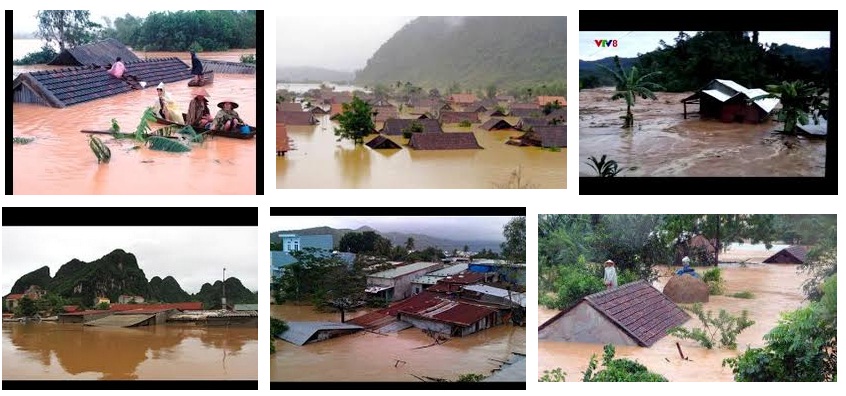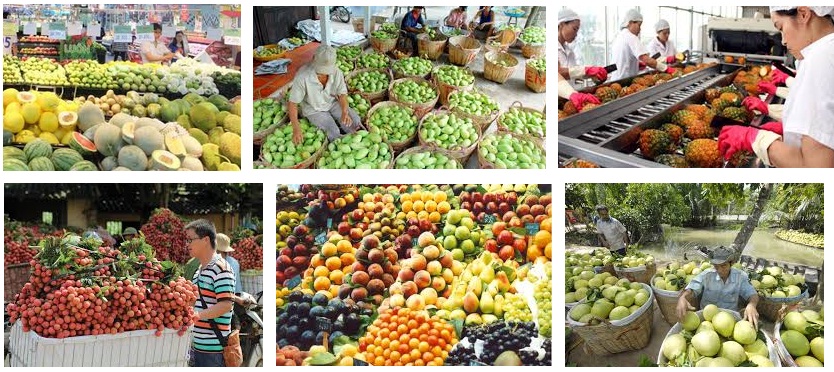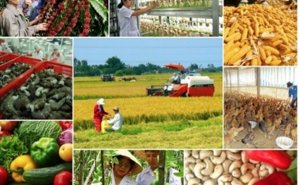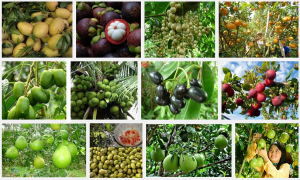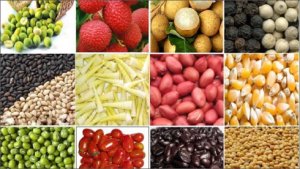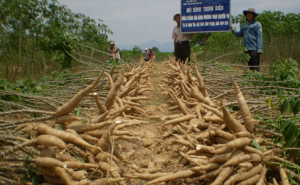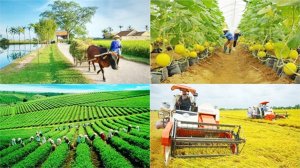|
VIETNAM AGRICULTURE IN 2016: PASSING A TOUGH EXAMINATION
Friday, 2017/01/13 | 13:21:29
|
|
Vietnam’s agriculture and overall food system are at a turning point. The country has emerged as one of the world’s leading exporters of agro-food commodities and is among the top five for aquatic products, rice, coffee, tea, cashews, black pepper, rubber, and cassava. However, the sector is experiencing a low quality of growth.
The effects of climate change are now substantially manifested in the Mekong Delta, through sea level. In addition to sea level rise, rainfall has increased by as high as 177% during winter in Soc Trang, and a 30% annual increase has also been observed. In the last 10 years alone, natural disasters have cost Vietnam around 1.5% of GDP each year.
In early 2016, salt-water intrusion is a growing risk to agricultural production, hastened by upstream damming and mangrove decline. El Niño is a phenomenon consisting of changing ocean temperatures in the equatorial Pacific. The water discharge in upstream of Mekong river declined by 900 m3/s. Salinity intrusion led to increased salinity of water in rivers and irrigation canals. Salinity (4g/l) expanded through Tien and Hau Rivers by up to 45-65 km and 55-60 km, respectively. The drought has thus resulted in the decrease of groundwater levels and the most extensive salinity intrusion in last 90 years. The severe drought and salinity intrusion strongly affected 11 of the 13 provinces in the Mekong Delta. Some 400,000 ha of cropland have been affected, of which 25,900 ha were left fallow. Rice areas affected by drought and salinity intrusion rapidly increased from 139,000 ha in mid-March 2016 to 224,552 ha by mid-April 2016, with the damage value of $US 360 million.
In Northern Vietnam, heavy chilly was reportedly occurred after 40 years in fourteen provinces from January to March 2016. It killed 52,000 heard of cattle and 150,000 ha of rice with the damage value of $US 18 million.
In late 2016, typhoons and flood seriously damaged agricultural production in central coast regions from October to December. Accordingly, the damage of 520 thousand, 148 thousand and 388 thousand ha of rice, non-rice crops and perennial crops, respectively, were noticed. In husbandry, 75,386 heads of domestic animals and 1.75 million heads of poultry died,with the damage value of $US 1.8 billion.
Agriculturally, GDP growth rate obtained 1.2%, with crop production reduced 0.9%, husbandry increased 5.4%; forestry products increased 6.17%; aquaproducts increased 2.91%. Early six month GDP growth firstly obtained its negative value of - 0.18%.
The total GDP annual growth rate finally gained the value of 6.21% to address the economic recovery in Vietnam. The export turnover of agriculture obtained $US 32.1 billion; including agro-products, aqua-products and processed wood & furniture products of $US 15.1, $US 6.99 and $US 7.23 billion, respectively.
The conversion of rice cultivated areas with low economic efficiency into maize, groundnut, vegetable, etc.. was recognized as 104.3 thousand ha. In Northern Vietnam, the conversed areas were estimated 24,594 ha as compared to 79,749 ha in Southern Vietnam.
Large field areas of 337,400 ha rearranged in rice production have been carried out in the country due to a committment between farmer and entrepreneur (northern VN of 78,000 ha and southern of 259,400 ha), 76,000 ha increased as compared to 2015.
Rice growing areas developed 7.75 million ha (76,000 ha decreased) with rice production of 44.2 million T (1.2 million t decreased) and average yield of 5.71 t/ha. The milled rice export of 4.88 MT obtained the turnover value of $US 2.2 billion (21.2 % decreased).
Maize growing area is 1.179 million ha with average yield of 4.60 t/ha. Total maize production gained 5.10 million T (1.5% increased).
Cassava growing area is 560,000 ha (increasing of 1.8%), and obtained 10.64 million T (increasing of 2.3%), with cassava productivity of 19 t/ha (increasing of 2.7%). The export turnover of cassava products offered $US 994 million (24.6 % decreased) with the volume of 3.66 million T (12.3% decreased) as compared to 2015.
Fruit orchards developed 848,645 ha (2.6% increased). Production obviously increased in dragon fruit of 15.6%, avocado of 13.15%, citrus of 5.2%, guava of 16.3%, coconut of 2.3%. In particular, export turnover of fruit and vegetable offered $US 2.4 billion (31.2% increased, or $US 1.7 billion increased) to open a new developing step. The key fruit species are listed as followed:
- Mango developed 84,770 ha, productivity of 7.34 t/ha, production of 707.800 T. - Banana developed 136,400 ha, productivity of 16.9 t/ha, production of 1.97 million T. - Dragon fruit developed 44,000 ha, productivity of 22.82 t/ha, production of 817,800 T. - Pineapple developed 40,900 ha, productivity of 16.3 t/ha, production of 579,900 T. - Mango developed 84,770 ha, productivity of 7.34 t/ha, production of 707.800 T. - Durian developed 32,300 ha, productivity of 14.5 t/ha, production of 336,900 T. - Orange developed 72,100 ha, productivity of 12.36 t/ha, production of 594,700 T. - Pomelo developed 54,700 ha, productivity of 11.68 t/ha, production of 474,500 T. - Longan developed 73,900 ha, productivity of 7.82 t/ha, production of 504,900 T. - Litchi developed 64,200 ha, productivity of 4.97 t/ha, production of 312,500 T. - Rambutan developed 26,000 ha, productivity of 14.9 t/ha, production of 314,700 T.
Sweet potato growing area is 120,000 ha and obtained 1.41 million T, with average productivity of 10.4 t/ha.
Vegetable areas increased up to 0.9 million ha (1.1% increased) with the production of 15. 97 million T (4.4% increased) and productivity of 17.75 t/ha (3.8 % increased).
Pulse crops obtained 160,000 ha (0.6% decreased), and gained the production of 107,000 t (0.1% decreased) with the productivity of 1.06 t/ha.
Soybean growing area is 98,000 ha (0.2% decreased) with the production of 145,000 ton (0.7% decreased) and productivity of 1.3948 t/ha (1.4% increased).
Groundnut growing area covered 195,000 ha (2.5% decreased) with the production of 460,000 ton (2.7% increased) and the average yield of 2.30 t/ha (2.0% increased).
Sugarcane developed 279.500 ha (5,000 ha decreased) with the production of 2018.5 million T and average yield of 64.5 t/ha.
Rubber area is 981,575 ha including 614,000 ha for production of 1.01 million ton of latex (0.07% increased). The average yield offered 1.65 t/ha. The export turnover of rubber increased its volume and its turnover of 10.6% and 9.0%, respectively as compared to 2015.
Cashew nut cultivated area is slightly reduced 287,000 ha (1.0% decreased) with the productivity of 1.08 t/ha (4% decreased) and the production of 301,000 ton (4.3% decreased). The export turnover of cashew nut products offered a new record of over $US 2.84 billion (18.4% increased) and a volume of 347,000 T (5.6% increased).
Black pepper is welcome to its promotion of over 110,257 ha including 60,000 ha for production. Pepper production obtained 193,000 T and the average yield gained 2.54 t/ha. The export turnover of black pepper offered $US 1.42 billion (12.9% increased) with 177,000 t (34.3% increased).
Coffee growing areas is 643,000 ha (599,000 ha harvested) with the average yield of 2.43 t/ha (0.2 t/ha decreased) and the production of 1.46 million T. The export turnover of coffee offered a new record of $US 3.36 billion (25.6% increased) with 1.79 million T (33.6% increased).
Tea growing area is 133,400 ha (0.2% decreased) with the production of 1.03 million ton (1.21% increased) and the average yield of 8.69 t/ha (fresh young leaves).
Coconut cultivated area is 145,000 ha including 128,000 ha for production with the average yield of 9.45 t/ha and the production of 1.21 MT.
Total meat production obtained 5.06 million T (5.3% increased) with 2.52 m, 5.48 m, 0.283 m, 29.1 m and 361.7 m heads of buffalo, cow, dairy cow, pig and poultry, respectively, in particular, chicken of 277.2 million head (6.9% increased). Husbandry growth rate increased 5.4% as compared to 2015.
Aqua-production obtained 6.73 million (2.5% increased). Culture areas developed 1.3 million ha with total production of 3.65 million T, including brackish shrimp culture of 650,000 T (9.1% increased).. Total value of aqua-products increased 2.91% as compared to 2015.
In 2016, forestry production value increased 6.17%; newly cultivated forest areas were developed 229,000 ha (7.1% reduced); newly replanted forest areas were noticed as 360,000 ha (8.8% increased). Covering areas by forest were estimated as 41.05%.
Salt-marsh areas developed 14,712 ha (3.0% decreased). Salt production obtained 1.31 million T (11.4% decraesed).
Product value per ha obtained VND 82-83 million/ha in 2015 ($US 3,950/ha) overall. Fishery offered VND 183 million/ha ($US 8,710/ha) particularly. Agriculture value per ha in Ho Chi Minh City obtained VND 375 million (equal $US 17,000 / ha) with the highest rank in the country.
Up to now, the country has developed 2,235 communes, which were standardized as newly rural development title (25.07%).
Water irrigation potential meets the demand of 3.52 million ha of arable land, to assure 7.48 million ha of growing rice areas irrigated (96%), 1.65 million ha upland crops (45%). It means 30,000 ha and 20,000 ha increased annually could be well irrigated and drainaged, respectively.
All statistical figures are highlighted from the MARD review in December 2016.
Actually, mechanization and post-harvest technology must be prior to be invested to met our goal of added value increasing. Mechanization now becomes an urgent need especially for land preparation and harvesting. Because current labor cost has gradually increased ($US 6-8 per day).
Foremost among Vietnam's agricultural troubles was exceptionally adverse weather, including drought, flood, salinity and heat. Accordingly, it will be more serious in coming years due to extreme weather. Various challenges were addressed from the start to strengthen and inform work by the IAS how to improve the situation, how to mitigate the impacts of climate change, how to align research objectives with farmers’ needs and to analyze the yield gaps for the major crops in Southern Vietnam particularly the objectives of agricultural restructure by MARD.
Vietnam’s current preferential trade agreements (PTAs) with many of the negotiating TPP countries already provide low or duty-free rates. Major Vietnamese exports, such as coffee and natural rubber, are not expected to gain from an agreement. TPP could provide new opportunities where those agreements did not liberalize market access.
Rice and smaller export sectors (cassava starch, pepper, processed foods, and honey) could grow. The key mechanism as our Prime Minister mentioned is “land restriction”, which would be changed soon.
The IAS scientists must engage in dynamic partnerships around various common priorities, projects and cross-crop issues during the research programs by MARD and international projects, which included participants from an array of Vietnam Academy of Agricultural Science (VAAS)’s institutions and other organizations. The IAS would significantly boost its research impacts by making its work more effective to become a positive member of VAAS in coming year.
A tough examination has been just passed in 2016 but other challenges will come. Throughout history, scientific and technological advances have greatly impacted the agriculture industry. Early farmers improved their crop production by inventing the first hoes. Today, farmers improve crop production through the use of global positioning systems with the emphasis on “smart agriculture”.
The ideas that have changed farming methods must applied soon to growing crops and livestock. Any your kind cooperation to the IAS would be appreciated.
BUI CHI BUU The Institute of Agricultural Sciences for Southern Vietnam |
|
|
|
[ Other News ]___________________________________________________
|


 Curently online :
Curently online :
 Total visitors :
Total visitors :

